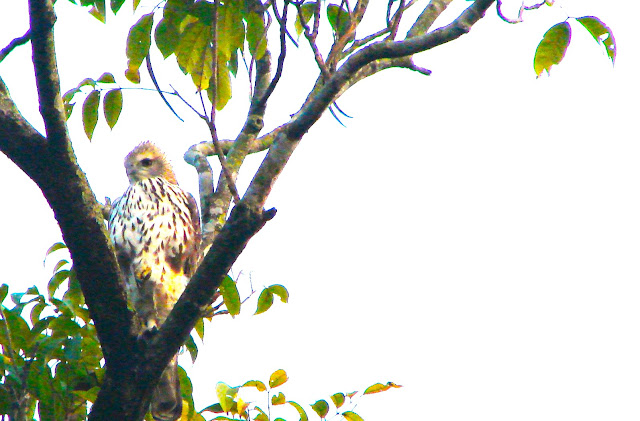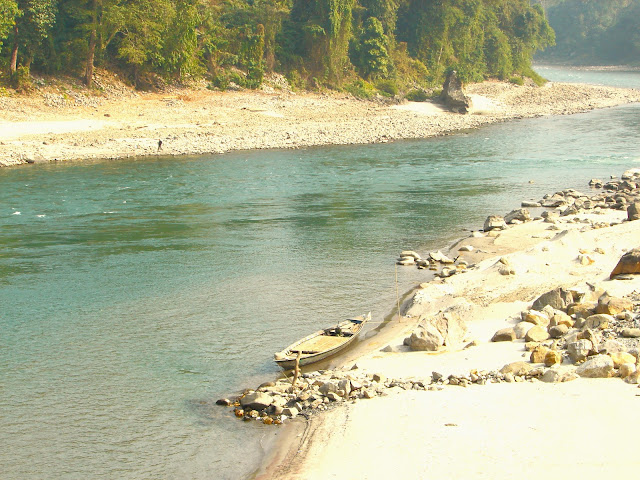 |
| A Camouflaged Hog Deer |
Manas National Park, located at the foothills of the Eastern Himalayas, is home to 31 endangered species of animals and is listed as one of the UNESCO Heritage Sites which gives it protection from illegal poaching and terrorist activities. It is famous for its Tiger, Elephant, and Rhinoceros reserve. I didn't get to see any during my trip in Jan 2013 but I thoroughly enjoyed the weekend spent there. It was an impromptu plan with my Sister-in-law. We just grabbed a couple of clothes, a backpack, and a bottle of water. As impromptu as it was, we didn't even have tickets or a vehicle. Thanks to Google, we looked up a couple of options to get there. The easiest way was to take the train.
Luckily we didn't have to wait long for a train. Most trains traveling north and west from Guwahati took the route via Barpeta Road. Since it was barely a 1.5-hour journey, we decided to buy whatever ticket was available to the closest station to the Park. We got two 2nd class tickets at a very nominal cost I think it was under Rs. 500. It was winter, so the journey was comfortable. The train was crowded but we managed to get a place to sit. The train journey was pretty uneventful and we reached Barpeta road on time.
At Barpeta Road station, we didn't have to look around much. There were taxis waiting for tourists heading to Manas National Park. It was a 2-hour drive and the fare was under Rs.1000 in 2013.
We had no bookings made for our stay. We took a friend's recommendation and headed for the Bansbari Manas National Park Guest House managed by Assam Tourism Development Corporation (ATDC). Luckily, we got a room for two days. The guest house was pretty well maintained and had the best Bengali food. If the management and chef are the same, I would recommend it anytime.
The Beki River was just a few minutes walk from the guest house. So after a quick, shower and a very late lunch, we headed for the river. We spent the evening, watching the sunset and the birds. The park hosts over 450 species of birds. It is also home to the endangered Bengal Florican,
 |
| An Egret and a flock of Cormorants |
The guest house arranged a vehicle for us for an early morning safari and a trip to Royal Manas National Park in neighboring Bhutan. Our early morning safari began at 5:30 a.m. It was cold and dark but probably the best time to meet a tiger making his morning rounds :). For safari, details check the Park's official website.
 |
| Sunrise on our way to the Safari |
The Park is divided into three zones. Panbari zone is a dense forest, while the Bhuyanpara zone is grassland and easy-to-spot animals. Bansbari Zone has most of the tourist amenities and is centrally located. We stayed at the Guest house in the Bansbari zone, so our safari trip started from there and then we headed towards Bhuyanapara before crossing into Bhutan.
 |
| Through the dense jungle road |
From Manas National Park on the Indian side, we drove down across the border to the Bhutan side which has the Royal Manas National Park. At the border, identifications are checked and entry permits are issued. Indian Nationals do not require a visa to enter Bhutan. The border village town is Panbang.
Though we missed the Tiger and Rhino, we did manage to spot other animals and birds during our safari trip. We saw hog deer, wild buffalos, nilgai, Capped langur, hawk-eagle, peacocks, and white-capped redstart to name a few.
 |
| Capped Langur |
 |
| Hawk-Eagle Fledgeling |
 |
| Crestless changeable Hawk-Eagle |
The changeable hawk eagles are native to the Himalayan foothills and are found across Nepal, India, Myanmar, the Malay Peninsula, and the Philippines. They are eagles with hawk-like features and they are called changeable due to the variation in their plumage color as they age and shed their feathers (molt)
 |
| Tiger Paw |
 |
| Peahen |
 |
| The Beki River on the Bhutan side |
 |
| Footbridge across the river |
The Beki River is a tributary of the Brahmaputra. It originates from the Kula Kangri glacier in Tibet and flows down Bhutan as Kuru Chchu before entering India where it is called Beki.
 |
| White-capped redstarts are natives of the Himalayan foothills and found across the Indian subcontinent, South Asia, and Central Asia |
We headed back from Panbang Village, Bhutan around the evening. Our weekend was over as well. The next day early morning we started for Guwahati on the same route as we had come. It was a short trip but fun nevertheless.












No comments:
Post a Comment
Please Share Your Thoughts :)